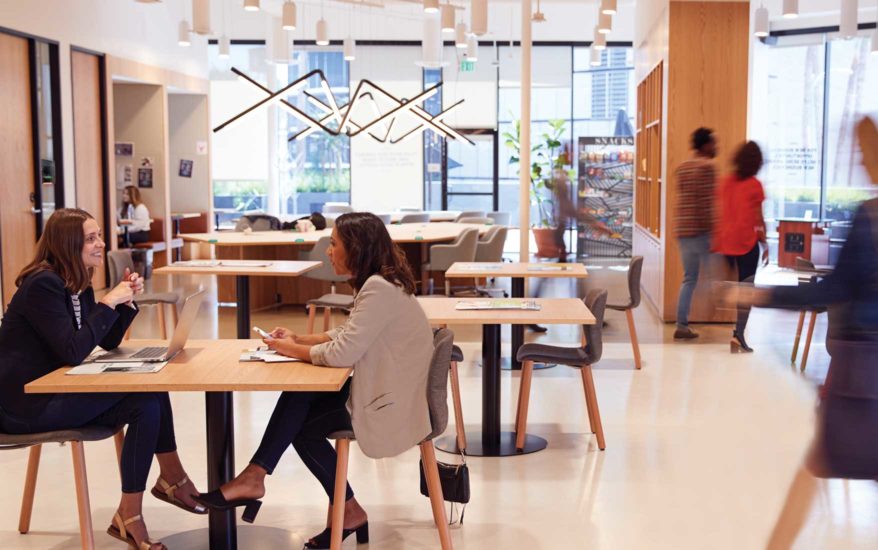
The 2020 workplace and shifts in the current climate are resulting in some very interesting statistics coming through as to:
- How flexible working is shaping our workplace?
- Why the employee experience really is important?
- What ROI and productivity look like?
- How collaboration is being enabled?
- What a connected workplace really looks like?
- And the importance of integrated technology.
Data reveals that 93% of business leaders agree that integration of technology is important to productivity.
However, only 13% of employers provide their full workforce with mobile phones? Yet with flexible working taking center stage in our working environment, it is also interesting to note too that 60% of employees are now using Microsoft Teams to hold video conferences.
And as we look ahead at office-based working though, there is still a general consensus that there is still no substitute for face-to-face interaction. With figures suggesting that while businesses recognize the importance of technology, there is still more we could be doing in terms of technology integration that enables employees to perform at their best, in a secure environment; which ultimately benefits the ROI and productivity.
1. People: fresh thinking required?
Flexibility and differentiation in the working environment is one that we are seeing as a priority in the 2020 workplace; and as the shift moves between remote working and back to office, as employees utilize a space that works for their current productivity levels, it has also been noted that 68% of people say that changes in the design of their workspaces has led to their productivity being significantly improved. So will this trend continue on into the second half of 2020?
Nearly half of people – 46% – say their offices don’t provide the right mix of spaces and meeting rooms for their employees to work productively.
As a result, more and more people are looking at remote working options: 62% of people expect to see remote working continue to increase over the course of the next year. However, there’s no clear agreement that it’ll deliver the solution that businesses and workers alike are looking for: only 44% of people say remote workers are more productive than on-site employees.
2. Places: meetings still aren’t being maximized
Despite the fact that many businesses want to make the most of their workspaces to enable better ways of working, there’s still a gap between that desire and what’s actually being delivered.
Almost half of people – 49% – say that providing the right mix of rooms and workspaces for their workforce is the biggest workspace challenge they face.
However, only 27% of employees say they always have access to the right types of meeting spaces when they need them. This causes a damaging knock-on effect on the smooth, efficient running of business: 37% of employees have to delay planned conversations when a meeting room isn’t available to them.
Furthermore, while remote working and video collaboration needs have increased, they aren’t universally favoured as the go-to option for meetings. Some 48% of people say that there’s no substitute for the face-to-face interaction lost through working remotely.
3. Technology: embraced, but with challenges
Businesses the world over are now really starting to enjoy the benefits of workplace technology integration in making work easier, more flexible and more efficient. For example, more than three-quarters of people – 76% – say technology is an effective way to cut down on business travel, along with all the financial and environmental savings that can therefore be generated.
Integration of this technology is particularly important to its successful implication. A majority of people say they can access work systems (59%) or manage meeting rooms and spaces (52%) on their mobile phones. Interestingly, however, only 13% of businesses provide all their employees with mobile phones, suggesting considerable take up of Bring Your Own Device (BYOD) policies.
That trend towards BYOD generates greater concerns around how sensitive business information is secured:
Some 45% of people say their data security isn’t keeping up with the new challenges caused by our evolving ways of working.
So how do we make sure that a flexible workforce is enabled this year, and beyond, as we see continuous shifts towards collaboration and productivity efforts in our modern workplace?
The insights into the above question form the basis of The Modern Workplace 2020: People, Places & technology Report. This 2020 release is the third edition of our research, that sets out to evaluate the people, places and technologies within our modern workplace, and how they’re driving changes within our working environments. Featuring responses from over 1,000 business leaders surveyed across seven countries: the USA, the UK, Germany, France, the Republic of Ireland, Singapore and Australia.
Download a copy of the Modern Workplace Research Report.



